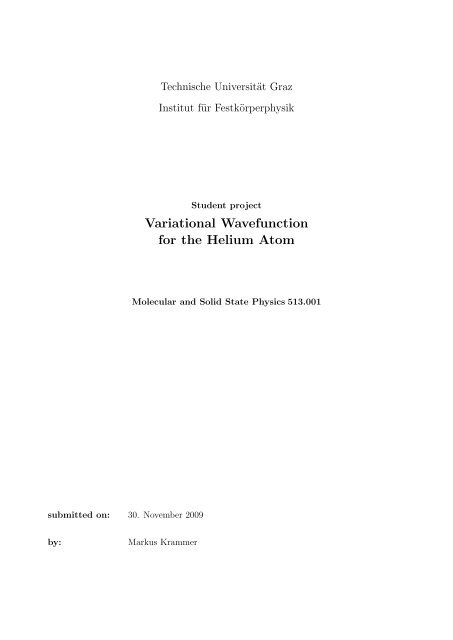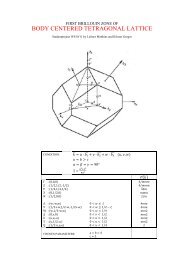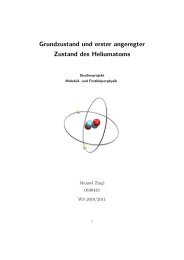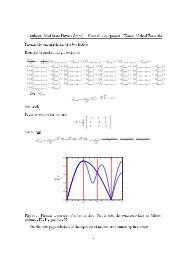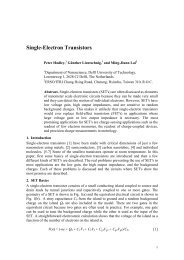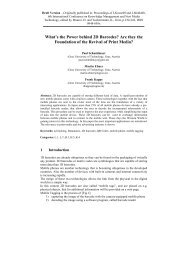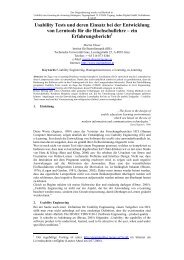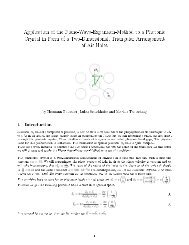Variational Wavefunction for the Helium Atom
Variational Wavefunction for the Helium Atom
Variational Wavefunction for the Helium Atom
Create successful ePaper yourself
Turn your PDF publications into a flip-book with our unique Google optimized e-Paper software.
Technische Universität GrazInstitut für FestkörperphysikStudent project<strong>Variational</strong> <strong>Wavefunction</strong><strong>for</strong> <strong>the</strong> <strong>Helium</strong> <strong>Atom</strong>Molecular and Solid State Physics 513.001submitted on: 30. November 2009by:Markus Krammer
Contents1 Problem 32 Optimization of a given wavefunction 33 Calculating <strong>the</strong> energy E (α) 33.1 〈x|Ĥ|ψ〉 . . . . . . . . . . . . . . . . . . . . . . . . . . . . . . . . . . . . . . . . . . . . . . . . . . 33.2 〈ψ|Ĥ|ψ〉 . . . . . . . . . . . . . . . . . . . . . . . . . . . . . . . . . . . . . . . . . . . . . . . . . . 43.3 〈ψ|Ĥ1|ψ〉 . . . . . . . . . . . . . . . . . . . . . . . . . . . . . . . . . . . . . . . . . . . . . . . . . 43.4 〈ψ|ψ〉 . . . . . . . . . . . . . . . . . . . . . . . . . . . . . . . . . . . . . . . . . . . . . . . . . . . 53.5 〈ψ|Ĥ2|ψ〉 . . . . . . . . . . . . . . . . . . . . . . . . . . . . . . . . . . . . . . . . . . . . . . . . . 53.5.1 Trans<strong>for</strong>ming to spherical coordinates . . . . . . . . . . . . . . . . . . . . . . . . . . . . . 53.5.2 Determinant of <strong>the</strong> Jacobi matrix . . . . . . . . . . . . . . . . . . . . . . . . . . . . . . . . 73.5.3 One more trans<strong>for</strong>mation . . . . . . . . . . . . . . . . . . . . . . . . . . . . . . . . . . . . 93.5.4 Solving <strong>the</strong> integral . . . . . . . . . . . . . . . . . . . . . . . . . . . . . . . . . . . . . . . 94 Optimizing <strong>the</strong> Energy 102
1 ProblemThe Hamitonian <strong>for</strong> <strong>the</strong> helium atom isĤ = − 2 (∇22m 1 + ∇ 2 2e2) 2− −4πɛ 0 r 12e24πɛ 0 r 2+e24πɛ 0 r 12(1)where r 12 is <strong>the</strong> distance between <strong>the</strong> two electrons.There is no analytical solution <strong>for</strong> <strong>the</strong> Schrödinger equation <strong>for</strong> this problem. So in a first step we neglect <strong>the</strong>electron electron interaction (term 5 in equation 1) to get an idea of how <strong>the</strong> real wavefunction could look like.Solving <strong>the</strong> Schrödinger equation <strong>for</strong> this simplified problem leads to <strong>the</strong> following wavefunction <strong>for</strong> <strong>the</strong> groundstate:ψ (r 1 , r 2 ) = 1 (a 3 exp −2 r )1 + r 2(2)0a 0This approximation is, of course, not very good. But it gives us an idea of how a better approximation couldlook like. So we try a variational wavefunction:ψ (r 1 , r 2 , α) = 1 (a 3 exp −α r )1 + r 2(3)0a 0Now, as we have made a decision of how our approximate wavefunction <strong>for</strong> <strong>the</strong> ground state should look like,we can optimize it.2 Optimization of a given wavefunctionTo optimize a wavefunction, we have to calculate <strong>the</strong> energyE (α) = 〈ψ|Ĥ|ψ〉〈ψ|ψ〉(4)and find <strong>the</strong> lowest energy depending on our parameter. If we would have more than one Parameter (e.g.coefficients of a polynomial that we multiply with our wavefunction) we would have to find <strong>the</strong> global minimumof our energy. But since we have just one parameter, finding <strong>the</strong> minimum energy is pretty easy.dE (α)dα = 0 (5)Equation 5 gives us <strong>the</strong> optimized parameter α (Energy must be <strong>the</strong> global minimum <strong>for</strong> <strong>the</strong> best α, so we haveto check whe<strong>the</strong>r this energy is <strong>the</strong> global minimum or not).3 Calculating <strong>the</strong> energy E (α)3.1 〈x|Ĥ|ψ〉The Laplace operator in spherical coordinates looks like this:∇ 2 i = 1 ( )∂ri2 ri2 ∂ 1 ∂ ∂ 1 ∂ 2+∂r i ∂r i ri 2 sin θ sin θ i +i ∂θ i ∂θ i ri 2 sin2 θ i ∂ϕ 2 i(6)Now we let <strong>the</strong> Laplace operator sink on <strong>the</strong> wavefunction:∇ 2 i ψ = 1 (∂ri2 r 2 ∂ 1i∂r i ∂r i a 3 exp −α r )1 + r 20a 0∇ 2 i ψ = − α a 4 01r 2 i(∂ri 2 exp −α r )1 + r 2∂r i a 0∇ 2 i ψ = − α a 4 01r 2 i( (2r i exp −α r )1 + r 2− α (ri 2 exp −α r ))1 + r 2a 0 a 0 a 03
∇ 2 i ψ = α a 4 0( α− 2 ) (exp −α r )1 + r 2a 0 r i a 0(7)Putting this into 〈x|Ĥ|ψ〉 returns:with〈x|Ĥ|ψ〉 = ( 2∑i=1(− 2(α α− 2 ) ) )−2e2 + e22m a 0 a 0 r i 4πɛ 0 r i 4πɛ 0 r 121a 3 0(exp −α r )1 + r 2a 0 2=e2(8)ma 0 4πɛ 0this leads to〈x|Ĥ|ψ〉 =2ma 4 0( 2∑ (− α2− 2 − α ) )+ 1 (exp −α r )1 + r 22ai=1 0 r i r 12 a 0(9)3.2 〈ψ|Ĥ|ψ〉With equation 9 it is not difficult to write down 〈ψ|Ĥ|ψ〉:〈ψ|Ĥ|ψ〉 =∫( 2∑· · · dx 1 dy 1 dz 1 dx 2 dy 2 dz 2∫R 2 (− α2− 2 − α ) )+ 1ma 6 0 2ai=1 0 r i r 121a 6 0(exp −2α r )1 + r 2a 0The first four terms in this integral are no problem to solve. Only <strong>the</strong> last term with <strong>the</strong> r 12 is a bit harder toevaluate. So we split it up into two parts:∫( 2∑〈ψ|Ĥ1|ψ〉 = · · · dx 1 dy 1 dz 1 dx 2 dy 2 dz 2∫R 2 (ma 7 − α2− 2 − α ) ) (exp −2α r )1 + r 2(11)6 0 2ai=1 0 r ia 0(10)and∫〈ψ|Ĥ2|ψ〉 =· · · dx 1 dy 1 dz 1 dx 2 dy 2 dz 2∫R 2 (1ma 7 exp −2α r )1 + r 26 0 r 12 a 0(12)3.3 〈ψ|Ĥ1|ψ〉The integrals∫· · · dx 1 dy 1 dz 1 dx 2 dy 2 dz 2∫R 2ma 7 6 0(− α2− 2 − α ) (exp −2α r )1 + r 22a 0 r 1 a 0and∫· · · dx 1 dy 1 dz 1 dx 2 dy 2 dz 2∫R 2 (− α2ma 7 − 2 − α ) (exp −2α r )1 + r 26 0 2a 0 r 2 a 0are exactly <strong>the</strong> same, so we can write∫〈ψ|Ĥ1|ψ〉 =· · · dx 1 dy 1 dz 1 dx 2 dy 2 dz 2∫R 2ma 7 6 0(− α2− 2 2 − α ) (exp −2α r )1 + r 2a 0 r 1 a 0(13)Now we tans<strong>for</strong>m it into spherical coordinates and with <strong>the</strong> Jacobi determinant of <strong>the</strong> trans<strong>for</strong>mation we get:dx 1 dy 1 dz 1 dx 2 dy 2 dz 2 = r1 2 sin θ 1 r2 2 sin θ 2 dr 1 dϕ 1 dθ 1 dr 2 dϕ 2 dθ 2 (14)Our integral does not depend on ϕ i and θ i , so we can integrate <strong>the</strong>se 4 variables seperately:∫ 2π∫ π ∫ 2π ∫ πdϕ 1 dθ 1 dϕ 2 dθ 2 sin θ 1 sin θ 2 = (4π) 2 (15)0 0 0 04
Figure 1: Trans<strong>for</strong>mation, <strong>the</strong> ˜z axis has <strong>the</strong> same direction as ⃗r 1and ˜z 2 as we are used to.˜x 2 = r 2 cos ϕ 12 sin θ 12 (24)ỹ 2 = r 2 sin ϕ 12 sin θ 12 (25)˜z 2 = r 2 cos θ 12 (26)So now we need to know <strong>the</strong> relation between x 2 , y 2 , z 2 and ˜x 2 , ỹ 2 , ˜z 2 . For this we write down <strong>the</strong> basis vectors:ê˜z = ⃗r 1r 1ê˜z =⎛⎝ cos ϕ 1 sin θ 1sin ϕ 1 sin θ 1cos θ 1⎞⎠ (27)êỹ = ê˜z × ê z|ê˜z × ê z |êỹ =⎛1⎝|ê˜z × ê z |cos ϕ 1 sin θ 1sin ϕ 1 sin θ 1cos θ 1⎞⎛⎠ × ⎝001⎞⎠êỹ =⎛1⎝|ê˜z × ê z |sin ϕ 1 sin θ 1− cos ϕ 1 sin θ 10⎞⎠6
where ˜M 1 , ˜M2 , ˜M3 and M are <strong>the</strong> more complicate parts of <strong>the</strong> Jacobi matrix with <strong>the</strong> trans<strong>for</strong>mation to r 2 ,ϕ 12 and θ 12 .∣ ∣∣∣∣∣∣∣∣∣ r 1 cos ϕ 1 sin θ 1 r 1 sin ϕ 1 cos θ 1˜M20 −r 1 sin θ 1˜M3|J| = cos ϕ 1 sin θ 1 0 00 0 M0 0∣∣ ∣∣∣∣∣∣∣∣∣ −r 1 sin ϕ 1 sin θ 1 r 1 cos ϕ 1 cos θ 1˜M10 −r 1 sin θ 1˜M3− sin ϕ 1 sin θ 1 0 00 0 M0 0∣∣ ∣∣∣∣∣∣∣∣∣ −r 1 sin ϕ 1 sin θ 1 r 1 cos ϕ 1 cos θ 1˜M1r 1 cos ϕ 1 sin θ 1 r 1 sin ϕ 1 cos θ 1˜M2+ cos θ 1 0 00 0 M0 0∣∣ ∣∣∣∣∣∣∣ −r 1 sin θ 1˜M3|J| = r 1 cos 2 ϕ 1 sin 2 0θ 10 M0∣ ∣∣∣∣∣∣∣ −r 1 sin θ 1˜M3r 1 sin 2 ϕ 1 sin 2 0θ 10 M0∣ ∣∣∣∣∣∣∣ r 1 sin ϕ 1 cos θ 1˜M20−r 1 sin ϕ 1 sin θ 1 cos θ 10 M0∣ ∣∣∣∣∣∣∣ r 1 cos ϕ 1 cos θ 1˜M10−r 1 cos ϕ 1 sin θ 1 cos θ 10 M0∣∣∣∣|J| = −r 2 1 sin 3 θ 1 |M| − r 2 1 sin 2 ϕ 1 sin θ 1 cos 2 θ 1 |M| − r 2 1 cos 2 ϕ 1 sin θ 1 cos 2 θ 1 |M|For <strong>the</strong> integral trans<strong>for</strong>mation we need <strong>the</strong> absolute value of <strong>the</strong> determinant of <strong>the</strong> Jacobi matrix.||J|| = r 2 1 sin θ 1 ||M|| (32)So now we just need to calculate <strong>the</strong> absolute value of <strong>the</strong> determinant of M:⎛ ⎞x 2 ( )M = ⎝ y 2⎠ · ∂ ∂ ∂∂r 2 ∂ϕ 12 ∂θ 12z 2M =⎛⎝ − cos ϕ ⎞ ⎛1 cos θ 1 sin ϕ 1 cos ϕ 1 sin θ 1− sin ϕ 1 cos θ 1 − cos ϕ 1 sin ϕ 1 sin θ 1⎠ ⎝ ˜x 2ỹ 2sin θ 1 0 cos θ 1 ˜z 2⎞⎠ ·(∂∂r 2∂∂ϕ 12)∂∂θ 12As <strong>the</strong> trans<strong>for</strong>mation matrix has no dependence on r 2 , ϕ 12 and θ 12 we can easily get <strong>the</strong> determinante:⎛⎞ ⎛ ⎞− cos ϕ 1 cos θ 1 sin ϕ 1 cos ϕ 1 sin θ 1 ˜x 2 ( ) ∣ |M| =⎝− sin ϕ 1 cos θ 1 − cos ϕ 1 sin ϕ 1 sin θ 1⎠ ⎝ ỹ 2⎠ · ∂ ∂ ∂ ∣∣∣∣∂r 2 ∂ϕ 12 ∂θ 12∣ sin θ 1 0 cos θ 1 ˜z 28
|M| =∣∣ ∣⎛− cos ϕ 1 cos θ 1 sin ϕ 1 cos ϕ 1 sin θ 1 ∣∣∣∣∣ ∣∣∣∣∣− sin ϕ 1 cos θ 1 − cos ϕ 1 sin ϕ 1 sin θ 1⎝sin θ 1 0 cos θ 1˜x 2ỹ 2˜z 2⎞⎠ ·(∂∂r 2∂∂ϕ 12∂∂θ 12) ∣ ∣ ∣∣∣∣The determinante of <strong>the</strong> second part is <strong>the</strong> same as we were calculating many times bevor:⎛⎝ ˜x ⎞2 ( ) ∣ ỹ 2⎠ · ∂ ∂ ∂ ∣∣∣∣∂r 2 ∂ϕ 12 ∂θ 12= −r2 2 sin θ 12∣ ˜z 2And <strong>the</strong> first part is also not really difficult:∣ − cos ϕ 1 cos θ 1 sin ϕ 1 cos ϕ 1 sin θ 1 ∣∣∣∣∣ − sin ϕ 1 cos θ 1 − cos ϕ 1 sin ϕ 1 sin θ 1 = cos 2 ϕ 1 cos 2 θ 1 +sin 2 ϕ 1 sin 2 θ 1 +cos 2 ϕ 1 sin 2 θ 1 +sin 2 ϕ 1 cos 2 θ 1 = 1∣ sin θ 1 0 cos θ 1So <strong>the</strong> absolute value of <strong>the</strong> determinante of <strong>the</strong> Jacobi matrix is:||J|| = r 2 1r 2 2 sin θ 1 sin θ 12 (33)3.5.3 One more trans<strong>for</strong>mationWith <strong>the</strong> trans<strong>for</strong>mation done be<strong>for</strong>e <strong>the</strong> integral is still not easy to solve. So we need one more trans<strong>for</strong>mation.We trans<strong>for</strong>m θ 12 to r 12 :r 2 12 = r 2 1 + r 2 2 − 2r 1 r 2 cos θ 12The Jacobi matrix <strong>for</strong> this trans<strong>for</strong>mation is:1 0 0 0 0 00 1 0 0 0 0|J| =0 0 1 0 0 00 0 0 1 0 00 0 0 0 1 0∣ r 12rr 1−r 2 cos θ 120 012r 2−r 1 cos θ 120r 12r 1r 2 sin θ 12∣ ∣∣∣∣∣∣∣∣∣∣∣||J|| =r 12r 1 r 2 sin θ 12(34)We need to take a look at <strong>the</strong> integration limits. In spherical coordinates <strong>the</strong>y were <strong>the</strong> same as we are usedto. But now we have to get <strong>the</strong> correct limits <strong>for</strong> r 12 . The limits <strong>for</strong> θ 12 were 0 and π, so r 12 now needs to gofrom |r 1 − r 2 | to r 1 + r 2 .3.5.4 Solving <strong>the</strong> integralWith all <strong>the</strong>se trans<strong>for</strong>mations (equations 33 and 34) <strong>the</strong> integral finally has a <strong>for</strong>m that is easy to solve:〈ψ|Ĥ2|ψ〉 =∫ ∞0∫ ∞ ∫ r1+r 2∫ 2π ∫ 2π ∫ πdr 1 dr 2 dr 12 dϕ 1 dϕ 120|r 1−r 2| 2(1 1ma 0 r 12 a 6 exp −2α r )1 + r 20a 0∫ ∞ ∫ ∞ ∫ r1+r= 2ma 7 2 (2π) 2 2dr 1 dr 200 0∫ ∞= 2ma 7 2 (2π) 200∫ ∞= 2ma 7 2 (2π) 2000|r 1−r 2|(∫ r1∫ r1+r 2dr 1 dr 20(∫ r1dr 1 dr 2 2r 2 +000(dr 12 r 1 r 2 exp −2α r 1 + r 2r 1−r 2dr 12 +∫ ∞∫ ∞dθ 1 r 2 1r 2 2 sin θ 1 sin θ 12r 12r 1 r 2 sin θ 12a 0)r 1dr 2∫ r1+r 2r 2−r 1dr 12))dr 2 2r 1 r 1 r 2 expr 1(−2α r )1 + r 2a 0(r 1 r 2 exp −2α r )1 + r 2a 09
∫ r10dr 2 r 2 2 exp (−λr 2 ) = ∂2∂λ 2 ∫ r10(dr 2 exp (−λr 2 ) = ∂2∂λ 2 − exp (−λr 1)+ 1 )= ∂(λ λ ∂λ exp (−λr r11)λ + 1 )+ 2 λ 2 λ 3( (r1= exp (−λr 1 ) −r 1λ + 1 )λ 2 − r 1λ 2 − 2 )λ 3 + 2 λ 3 = − exp (−λr 1) r2 1λ 2 + 2r 1 λ + 2λ 3 + 2 λ 3∫ ∞r 1dr 2 r 2 exp (−λr 2 ) = − ∂∂λ∫ ∞r 1dr 2 exp (−λr 2 ) = − ∂∂λ( )exp (−λr1 )λ(r1= exp (−λr 1 )λ + 1 )λ 2〈ψ|Ĥ2|ψ〉 = 2ma 7 0+ 2ma 7 0= 2ma 7 0(4π) 2 ∫ ∞0(4π) 2 ∫ ∞0(4π) 2 ∫ ∞0⎛((⎜dr 1 ⎝− exp − 2α ) r2 2α1r 1a 0⎛(⎜dr 1 ⎝r 1 exp − 2α⎛⎜dr 1 ⎝− r 1 2α(= 2 a0) 3∫ ∞2 (4π)ma 7 0 2α0a 0+ 2() 32αa 0dr 1(−With equations 16 and 17 this leads to:⎛ ⎛(〈ψ|Ĥ2|ψ〉 = 2 a0) 32 ⎜ ⎜(4π)ma 7 ⎝− ⎝ 2 2α( )0 2α3+ 24α a 0a 0(= 2 a0) 52 (4π)(− 2 ma 7 0 2α8 − 2 )4 + 2So finally we solved <strong>the</strong> integral:) 2⎞a 0+2α 2r1a 0+ 2( ) 3+ (2) 32α2αa 0 a 0) ⎛ ⎞⎞⎜ r 1r 1 ⎝a2α+ 1 ⎟⎟( ) 2 ⎠⎠ r 1 exp0 a 02αa 0(exp − 4α )r 1a 0+ (2() 3exp2αa 0(⎟⎠ r 1 exp −2α r 1(−2α r 1a 0)−2α r 1a 0) ⎞ ⎟ ⎠ r1( ) (r12 2α+ 2r 1 exp − 4α )r 1 + 2r 1 expa 0 a 0⎞1 ⎟) 2 ⎠ + 2a 0(4α⎞1 ⎟) 2 ⎠a 0(2α(− 2αa 0r 1))a 0)〈ψ|Ĥ2|ψ〉 =2ma 2 0π 2 5α 5 8(35)4 Optimizing <strong>the</strong> EnergyNow we calculated all terms to get <strong>the</strong> energy (see equation 4):E (α) = 〈ψ|Ĥ|ψ〉〈ψ|ψ〉= 〈ψ|Ĥ1|ψ〉 + 〈ψ|Ĥ2|ψ〉〈ψ|ψ〉With equation 18, 20 and 35 we get <strong>the</strong> result:E (α) = − 2 π 2 (4−α)ma 2 0 α 5π 2α 6+ 2 π 2 5ma 2 0 α 5 8( )E (α) = − 2 27ma 2 0 8 α − α2(36)10
As already explained in equation 5 <strong>the</strong> first derivative of <strong>the</strong> energy must be zerodE (α)dα = 0 = d ( ))(− 2 27dα8 α − α20 = − 2ma 2 00 = 27 8 − 2αSo <strong>the</strong> optimized value <strong>for</strong> α is:ma 2 0( 278 − 2α )α = 2716(37)As we can easily see from <strong>the</strong> energy E (α) this is <strong>the</strong> global minimum. The corresponding energy is (wi<strong>the</strong>quation 36):( ) 27E opt = E16( ( ) ) 2= − 2 27 27 27ma 2 0 8 16 − 16(= − 2 729ma 2 0 128 − 729 )256E opt = − 2 729ma 2 0 256(38)(39)The hartree E h is <strong>the</strong> atomic unit of energy (see also equation 8):E h =2ma 2 0= e24πɛ 0 a 0(40)So in hartree <strong>the</strong> energy would beE opt = − 729 hartree256(41)= −2.8477hartree (42)Putting <strong>the</strong> values = 1.054571628 · 10 −34 Js (43)m = 9.10938215 · 10 −31 kg (44)a 0 = 5.291772186 · 10 −11 m (45)e = −1.602176487 · 10 −19 C (46)into equation 39 results in:E opt = −1.24151 · 10 −17 J (47)= −77.4887eV (48)11


